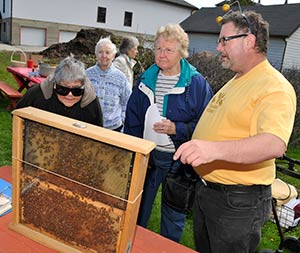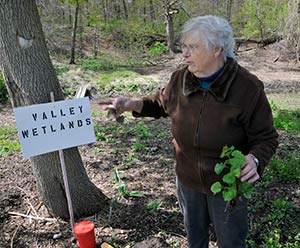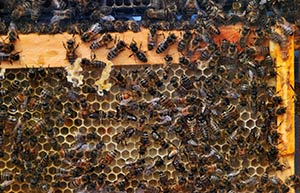Stooped over the parched dry earth on a sunny morning, a group of volunteers pulls Japanese knotweed, garlic mustard and other invasive species from the campus of the Sisters of St. Francis of Assisi. “Garlic Mustard Queens,” are what Sister of St. Francis of Assisi Mary Louise Schramer affectionately refers to the tireless helpers. Sisters of St. Francis of Assisi Linda Tan, left to right, Mary Jean Ansel and Rita Haderer and Charlie Koenen, a Milwaukee beekeeper, look at a colony of bees on the grounds of the Sisters of St. Francis of Assisi motherhouse. The sisters offered tours of their grounds as part of an Earth Day observance, April 21. (Catholic Herald photo by Ernie Mastroianni)
Sisters of St. Francis of Assisi Linda Tan, left to right, Mary Jean Ansel and Rita Haderer and Charlie Koenen, a Milwaukee beekeeper, look at a colony of bees on the grounds of the Sisters of St. Francis of Assisi motherhouse. The sisters offered tours of their grounds as part of an Earth Day observance, April 21. (Catholic Herald photo by Ernie Mastroianni)
It’s back-straining and seemingly never-ending work, but there’s laughter, camaraderie and conversation as the volunteers make progress. Once cleared, the land underneath will be primed to grow native plantings.
For hundreds of years, they have quietly served in isolated convents, maple-shaded hospitals, and schools and orphanages on their own ecologically minded campuses. They have run retreat centers and gardens and have cared for the earth. For decades, religious sisters from around the world have been little-noticed stewards of the land.
Since 1849, the Sisters of St. Francis of Assisi made their home in Milwaukee, south of the bay of Lake Michigan on a strip of land known by the native people as “Nojoshing” or “straight tongue.” The German immigrant nuns were pioneers, and among other vocations within their order, were called to become caretakers of the earth.
Sisters push to preserve property
Now, the sisters are pushing to preserve the property at 3221 S. Lake Drive, St. Francis, by finding new means to protect their 21.5 acres of open space. Thanks to a $20,000 grant from the Department of Natural Resources and a $3,500 grant from Freshwater Future, the sisters are closer to restoring the property to a more mindful, spiritual and natural state that will serve as a model for sustainable urban land use.
According to Sister of St. Francis of Assisi Helene Mertes, the climate grant from Freshwater Future will help develop a climate adaptive land use management plan for the motherhouse complex, incorporate climate resiliency, sustainability and best practice models, and will serve as a community teaching tool.
“We hired BHE Environmental Inc. from Cedarburg to help look into the future for climate change and how to focus different things on our property as the climate changes,” she explained. “We are looking at water management, and invasive species plants and restoration of the wetlands and building up of the wetlands and forest. The study will be produced into a document that will allow us the opportunity for future grants to preserve our land.”
The funding from Freshwater Future opened the opportunity for the DNR grant, according to Sr. Mertes. Sister of St. Francis of Assisi Helene Mertes explains the wetland area of the grounds of the motherhouse. Mertes is holding an example of garlic mustard which she cleared from the area. She became a licensed chemical applicator with a permit from the Wisconsin Department of Natural Resources in order to clear out invasive species. (Catholic Herald photo by Ernie Mastroianni)
Sister of St. Francis of Assisi Helene Mertes explains the wetland area of the grounds of the motherhouse. Mertes is holding an example of garlic mustard which she cleared from the area. She became a licensed chemical applicator with a permit from the Wisconsin Department of Natural Resources in order to clear out invasive species. (Catholic Herald photo by Ernie Mastroianni)
“When we did the environmental study on the campus, we had extremely invasive weeds in our Deer Creek wetland area, which borders the west end of the motherhouse grounds,” she said. “The Japanese knotweed was 9 feet tall. We were told by BHE to call the DNR to see if they could help us.”
Grant helps in removal of invasive species
Surprisingly, the area classified as a verified wetland and the sisters could apply for the grant to remove invasive species and restore the space with native plantings.
“It took most of the funding to get rid of the weeds,” explained Sr. Mertes. “But this can be a renewable grant, so we are hopeful to be able to remove all of the invasive species as it is an ongoing problem.”
In addition to the grant for restoring the campus, the sister volunteers, retired sisters and approximately 25 lay volunteers have agreed to bring new life to this sacred ground.
For informationon the Reiti Hermitage on the campus of the Sisters of St. Francis of Assisi, 3221 S. Lake Drive, St. Francis, call (414) 744-1160 or email:hermitage@lakeosfs.org. A brochure is available at tinyurl.com/8d4tuz3. |
With proceeds from the annual “Wine and Vine” event in August, the sisters are restoring the 1912 grape arbor. On Aug. 18, the sisters hosted their fourth “Wine and Vine” event to celebrate the 100th anniversary of the grape arbor.
“We’ve actually been building up to this event for the past few years,” said Sister of St. Francis of Assisi Stella DeVenuta, a coordinator of Wine and Vine. “The arbor was constructed in 1912 and has been a focal point in the community,” she explained. “It has been a place of beauty, quiet and reflection for the sisters and others. And it has been a host to numerous receptions and other activities, a tradition what we hope will continue for many years to come.”
Reiti Hermitage is sacred space
Nestled in the midst of the grape arbor, wetlands and motherhouse, is the Reiti Hermitage, a studio-cottage with screen porch, for those needing a respite from the outside world. Available for a day or longer, the hermitage provides a scared space for women, men or couples seeking a place for solitude and prayer.
“The hermitage is very popular and used constantly, year round,” said Sr. Mertes. “Some people come and ask for spiritual direction from one of the sisters, but most come for quiet time and private retreat from the stresses in their lives.”
Continuing with the sisters’ desire to provide an overall campus of sustainability, respect for the land and peace, they are making other improvements to develop a complete sense of spirituality.
Between two vegetable gardens is the composting area. Compost from food scraps has fertilized the large vegetable garden, which provides fresh vegetables for meals during the summer for the sisters at the motherhouse and Clare Hall. Sisters who live off campus, but desire a space to garden, cultivate a smaller garden on the grounds.
Future dreams include ecology center
“We also have a bat house down by the garden area, so bats can take care of the mosquitoes and insects in the area,” said Sr. Mertes. “One of our really big dreams is to have an ecology center and use it as a training tool for bio-diverse gardening. The building would have a full kitchen, bathroom and library and we could host classes or school groups. As many of us are educators, this would allow us to continue this teaching trend in the future.” The Sisters of St. Francis of Assisi have purchased seven beehives as part of their effort to be return their St. Francis campus to its natural state. Local beekeeper, Charley Koenen, tends to the hives which are expected to produce 240 pounds of honey this year. More photos from the motherhouse grounds can be viewed and purchased at photos.chnonline.org. (Catholic Herald photo by Ernie Mastroianni)
The Sisters of St. Francis of Assisi have purchased seven beehives as part of their effort to be return their St. Francis campus to its natural state. Local beekeeper, Charley Koenen, tends to the hives which are expected to produce 240 pounds of honey this year. More photos from the motherhouse grounds can be viewed and purchased at photos.chnonline.org. (Catholic Herald photo by Ernie Mastroianni)
The sisters recently received approval to construct a hoop house and steam house to allow the early cultivation of more native plants said Sr. Mertes.
“We can also get some of our seasonal plants started earlier as well,” she said. “We have increased our orchard and added apples, cherries, pears, peaches, plum and apple trees.”
After St. Mary’s Academy closed, the soccer field remained unused. The sisters are planning to transform the green space into an urban forest with walkways winding among groves of sugar maples, red maples and beech trees. Between the orchard and the urban forest, a labyrinth is planned.
Green burial grounds possible
Plans also include green burial grounds. The sisters are exploring an environmentally safe option that interests people who are looking for an alternative to cremation and standard casket and vault burial.
Since April, the campus has been abuzz with the addition of honeybee hives. According to Sister of St. Francis of Assisi Margaret Kruse, the introduction of the bees is just one of the endeavors linked to applying ideas from the Sisters of St. Francis of Assisi’s Land Use Committee.
“We purchased seven beehives,” she said. “We have been having pollination happening in the neighborhood and up to 2.5 miles away. So, the hives are really helping. We expect over 240 pounds of honey from these hives this year.”
Caring for the bees is local beekeeper Charley Koenen, who gave a presentation on the benefits of honeybees to the sisters before the bees’ arrival. He compared the bee colony, which is interdependent, to the community life of the sisters. He compared the framework of the hive to the congregation – sisters working together for the betterment of the community and the benefit of the earth in general.
For Sr. Schramer, the extensive work on the campus will provide a sense of retreat, serenity and peace to all who visit the grounds.
“We want to develop the whole spiritual aspect here, and I think we are doing that,” she said. “It is a reflective area, and if we eventually develop the ecological center, it will also be good for overall spirituality and respect for the earth.”
According to Sr. Kruse, visitors usually comment on the deep sense of peace felt when walking the grounds.
“They say that they can feel God’s presence in the environment themselves and all we are doing here to protect this space,” she said. “We try to live and speak our faith and our desire is that people coming to the property will experience God. That says a lot about what our faith is about. We have 44 sisters here on the motherhouse grounds who are praying around the clock and that whole atmosphere of prayer and spirit comes forth from that. I think all that together speaks of our faith.”
